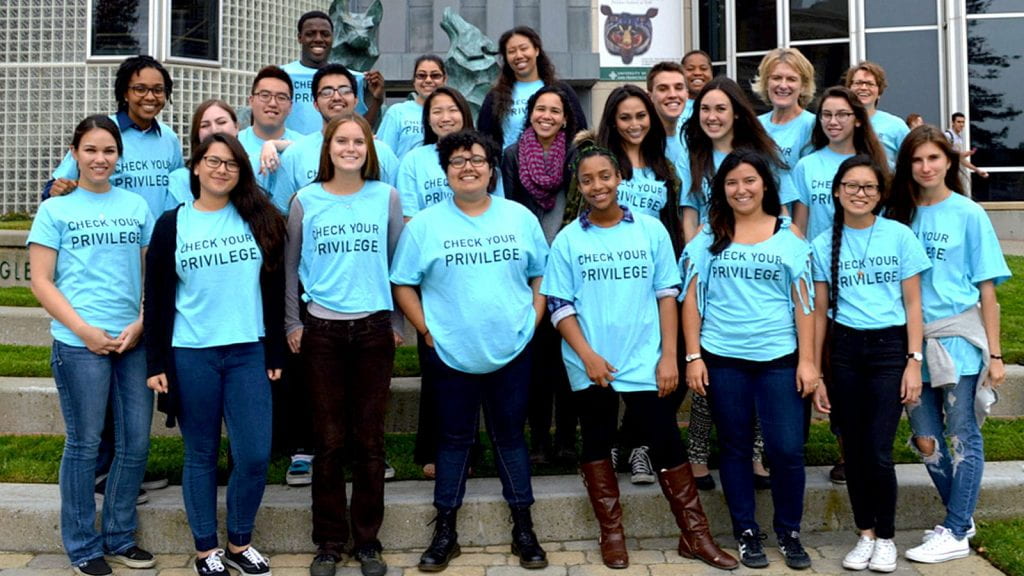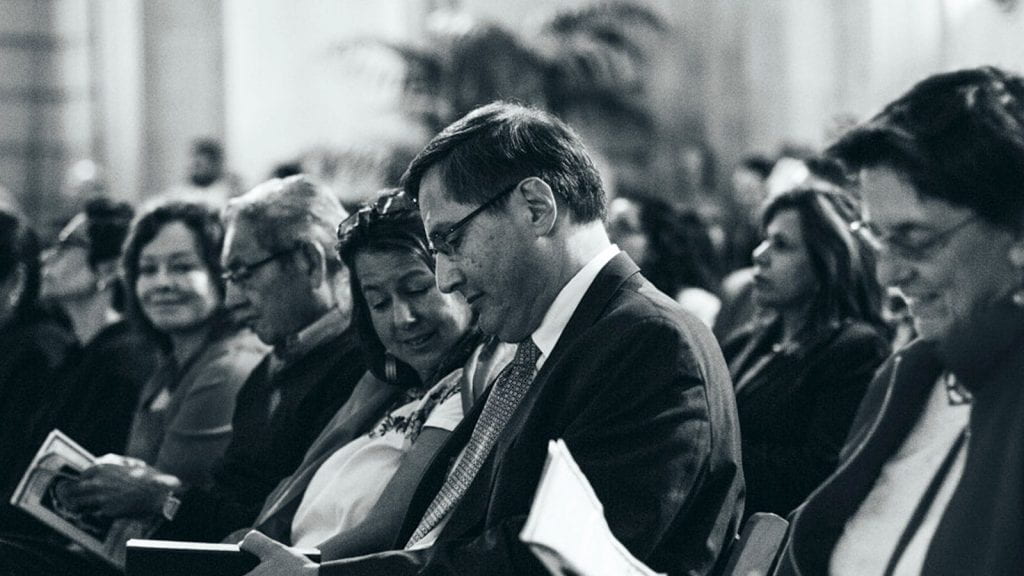Ja’Nina Walker, Assistant Professor of Psychology, reflects on the Check Your Privilege campaign and the steps we need to take to continue raising awareness.

Privilege: a special right, advantage or immunity granted or available only to a particular person or group of people (New Oxford Dictionary, n.d.)
Colorblind racial ideology: proposes that the most effective means of ending discrimination is through equalitarianism (without regard to race, culture or ethnicity) often accompanied with an avoidance of conversations about race (Neville, Awad, Brooks, Flores, & Bluemel, 2013).
During the 2014-2015 academic school year, a campaign was launched for the University of San Francisco community. The goal of the campaign was to bring awareness to various social privileges that impact students, faculty, and staff on and off campus. The Check Your Privilege Campaign received local and international attention with many universities replicating the campaign on their various campuses. While the response to the campaign was vast, from extreme support to utter disdain, the relevance of the campaign on this campus cannot go understated.
Understanding Colorblind Racial Ideology
Many individuals in the United States believe that colorblind racial ideology (i.e., I don’t see color, I just see people) is beneficial to race relations. However, research has continued to show that not acknowledging race, and the associated structural inequalities, negatively impacts intergroup relations (Holoien & Shelton, 2012; Plaut, Thomas, & Goren, 2008; Richeson & Nussbaum, 2004). When one does not consider the ways in which people of color are viewed in the world, they are ignoring a key component of that person’s lived experience. While colorblind racial ideology only accounts for racial and ethnic differences, one can propose that tenets of colorblind racial ideology may move beyond race and into other social categories. If one avoids conversations around race, they may also fail to acknowledge structural inequalities around sex, gender, religion, class, sexual orientation, or differently abled bodies.
Understanding Privilege
Although we seek to produce change agents at USF, many students graduate with very little knowledge of the ways in which various social privileges impact the experiences of others. For example, in the United States, Christian holidays are recognized as Federal Holidays, while Jewish and Muslim holidays are not; women make less than men on the workforce; Black men and women are more likely to be arrested and sentenced to prison (or killed) for lesser crimes than their White counterparts (Alexander, 2012; Bonilla-Silva, 2014); and transgender women are being murdered at a heinous rate. To fully understand the impact and reach of privilege one must remember:
- We all have some form of privilege that will increase or decrease depending on our social setting.
- We can facilitate within ourselves, and others, deep critical understandings of how our individual privilege(s) perpetuate structural privileges and inequalities.
- We can use our privilege to advocate for others who are less privileged, in a certain situation, than ourselves.
In order to uphold our Jesuit mission, we must critically examine the ways in which we are accurately infusing conversations around power, privilege, and difference into our curriculums and co-curricular activities so that the USF community can change the world from here.
Creating Change Agents
To put things into perspective, a pre-post study was conducted in tandem with the university wide Check Your Privilege Campaign to test the feasibility of a social marketing campaign. Prior to the campaign, students were fairly knowledgeable about various social privileges, and on average reported relatively low colorblind racial ideology. However, these constructs significantly impacted student interest in social justice activities. Students who reported higher colorblind racial ideology were less likely to report interest in social justice activities. Students who were more knowledgeable about heterosexual privilege were more likely to report positive outcome expectations from engagement in social justice activities (Walker et al., under review).
We also examined across discipline knowledge of social privilege, the perpetuation of colorblind racial ideology, and interest in social justice. We found that on average, students in the schools of Management and Nursing and Health Professions were the least aware of individual and structural privileges and social inequalities (particularly racial and class privileges) when compared to Arts/Humanities, Social Science, and Science majors. Additionally, management students were the least aware of male privilege and Christian privilege. Science majors, in addition to management students, were the least aware of heterosexual privilege. With regard to colorblind racial ideology, management students reported the highest levels. Lastly, Management, Science, and Nursing majors were the least likely to report interest in social justice activities when compared to Arts/Humanities and Social Science majors (Poole & Walker, under review).
Our Jesuit Mission
These findings should serve as a call to the USF community to consider the ways in which we instill within our students the ability to think critically about the world in which they live. Given that students who uphold colorblind racial ideology are substantially less likely to show interest in, and positive outcome expectations from, engagement in social justice activities, we must teach them the fallacy in such messaging. Saying that one does not see race, sex, gender, class, religion, sexual orientation, or ability status not only limits one’s ability to see the humanity in others, such thinking is in stark contrast to our value of cura personalis. We must reflect on our similarities and acknowledge our differences to uphold our Jesuit mission.
As a University community we can take action steps toward ensuring that our community maintains our core values:
- Provide mandatory diversity training for faculty and staff. If we want to ensure that our students are knowledgeable about diversity, and leave USF with a social justice framework, we must ensure that faculty and staff are well-informed about such topics. Providing optional trainings are not enough. What we know is that the individuals who have the largest learning curve in regard to diversity and multiculturalism, are less likely to attend optional trainings. Developing an interactive course on diversity (i.e., fallacy of colorblind racial ideology, microaggressions, implicit bias, tokenism in the classroom) similar to Think About It, or having faculty who extensively study issues around diversity conduct department specific trainings, would greatly benefit our community.
- Conversations around power and privilege must be infused within the curriculum. We must critically examine the ways in which conversations around privilege and power are conducted within and outside of classrooms. It is not enough to require students to take only one or two cultural diversity courses during their four years of study. If we want to produce men and women for and with others we must be diligent, especially within the schools of Management and Nursing, to ensure that all of our students are gaining an education that is inline with the University’s goals and expectations.
- Provide trainings, through the Center for Teaching Excellence, on how to conduct difficult dialogues around privilege and power. The CTE is an amazing resource for faculty and can use its platform to equip faculty with the skills needed to engage students in conversations around power and privilege. The CTE could offer Teaching Retreats, Summer Bookclubs, and Teaching Cafés on teaching and discussing power and privilege. The CTE and administration could even collaborate to produce a mandatory training for all new(ish) faculty on how to navigate infusing such discussions into their classrooms.
- Develop an Ombuds Office. One of the biggest barriers to effective conversations around privilege and power is accountability. Often times students experience egregious acts of racism, sexism, transphobia, and homophobia by faculty and staff. However, they do not know who they can talk to about their concerns without negative repercussions. Developing an ombuds office, where a non-bias party provides confidential, impartial and informal conflict resolution, and problem-solving services for offensive or unethical behavior, would greatly improve responsibility and accountability for all parties involved.
- Reinstate and Expand the Multicultural Recruitment and Retention Office. Although the Strategic Enrollment Management office seeks to ensure effective recruitment of all students, the dismantling of MRR has already shifted the culture and climate at USF around race and ethnicity. In an era where Affirmative Action is on the chopping block, yet students of color are not accurately represented on university campuses, we must not forget the need for such an important office with trained staff who use multiculturalism as their lens. For the past 20+ years MRR has successfully recruited and retained students of color who thrive at USF. Disassembling MRR has sent a message to the USF community that multicultural issues are no longer needed. Removing MRR is synonymous to colorblind racial ideology as its dismantling implies that the needs of students of color are no longer a priority. It is very important to have one office that specializes in the recruitment of students of color so that accountability is centralized as opposed to being dispersed among multiple Strategic Enrollment Management staff.
It is the responsibility of administration, faculty and staff to ensure that the USF community upholds our Jesuit mission. We must all be knowledgeable about the ways in which social privileges often perpetuate colorblind racial ideology. If we want our students to change the world from here, we must first reflect on our own knowledge, and then instill in them the skills to think critically about the world around them. We must ensure that the core values that rule our institution are at the center of each department, each course, each advertisement, each conversation, each meeting, and that equity is at the forefront of all of our minds.
References
Alexander, M. (2012). The New Jim Crow: Mass Incarceration in the Age of Colorblindness. New York: New Press.
Bonilla-Silva, E. (2014). Racism without Racists: Color-blind Racism and the Persistence of Racial Inequality in America. Lanham, MD: Rowman & Littlefield.
Holoien, D. S. & Shelton, J. N. (2012). You deplete men: The cognitive costs of colorblindness on ethnic minorities. Journal of Experimental Social Psychology, 48, 562-565. doi:10.1016/j.jesp.2011.09.010
Kellaway, M. & Brydum, S. (2015). These Are the U.S. Trans Women Killed in 2015. Retrieved from http://www.advocate.com/transgender/2015/07/27/these-are-trans-women-killed-so-far-us-2015
National Equal Pay Task Force. (2013). Fifty Years After the Equal Pay Act. Retrieved from https://www.whitehouse.gov/sites/default/files/equalpay/equal_pay_task_force_progress_report_june_2013_new.pdf
Neville, H. A., Awad, G. H., Brooks, J. E., Flores, M. P., & Bluemel, J. (2013). Color-blind racial ideology: Theory, training, and measurement implications in psychology. American Psychologist, 68, 455-466.
Plaut, V. C., Thomas, K. M., & Goren, M. J. (2008). Is multiculturalism or colorblindness better for minorities? Psychological Science, 20, 444-446. doi: 10.1111/j.1467-9280.2009.02318.x
Poole, S. M. & Walker, J. J. (under review). Are marketing students less culturally competent? Evidence from a survey of undergraduate students.
Richeson, J. A., & Nussbaum, R. J. (2004). The impact of multiculturalism versus color-blindness on racial bias. Journal of Experimental Social Psychology, 40, 417-423. doi:10.1016/j.jesp.2003.09.002
Thompson, D. (2013). How America’s Top Colleges Reflect (and Massively Distort) the Country’s Racial Evolution. Retrieved from http://www.theatlantic.com/national/archive/2013/01/how-americas-top-colleges-reflect-and-massively-distort-the-countrys-racial-evolution/267415/
Walker, J. J., Poole, S. M., Murray, S., Williams, S. L., Banks, C. J., Stallings, J. A, Balgobin, K.R., & Moore, D. P. (under review). Colorblind racial ideology and privilege awareness in relation to social justice among college students.

